
endangered
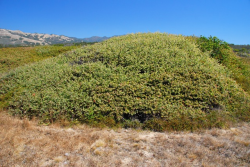
Arroyo de la Cruz manzanita, San Luis Obispo Co.
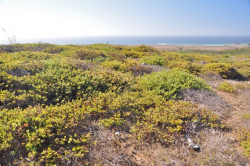
Arroyo de la Cruz manzanita, San Luis Obispo Co.
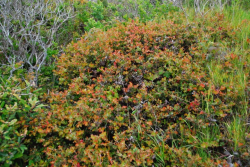
Arroyo de la Cruz manzanita, San Luis Obispo Co.
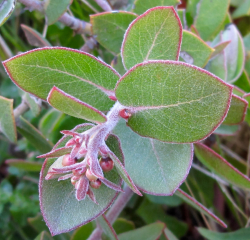
Arroyo de la Cruz manzanita, San Luis Obispo Co. Photo © Dylan M. Neubauer.
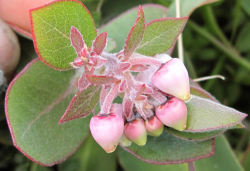
Arroyo de la Cruz manzanita, San Luis Obispo Co. Photo © Dylan M. Neubauer.



This fact sheet was prepared by Dylan M. Neubauer under award NA04N0S4200074 from the National Oceanic and Atmospheric Administration (NOAA), U.S. Department of Commerce (DOC). The statements, findings, conclusions, and recommendations are those of the authors and do not necessarily reflect the views of the NOAA or the DOC.
© Copyright 2006, Elkhorn Slough Coastal Training Program
Last updated: Mar 16, 2017 11:36
Common Names - Arroyo de la Cruz manzanita
Family - Ericaceae (Heath Family)
State Status - none
Federal Status - none
Habitat and Associates
Generally sandy to loamy soils, often on n-facing slopes where there is less competition with taller shrubs. In various communities including coastal bluff scrub, maritime chaparral, and coastal prairie/non-native grassland, and in ecotones between coastal scrub and maritime chaparral and grassland or oak woodland. In areas affected by fog and wind, with infrequent frost (Parker et al. 2009 & 2017, CNDDB 2017).
Associates include Adenostoma fasciculatum var. fasciculatum, Arctostaphylos hookeri subsp. hearstiorum, A. tomentosa subsp. tomentosa, A. t. subsp. rosei, Ceanothus maritimus, Ceanothus thyrsiflorus var. thyrsiflorus, and Frangula californica subsp. californica (Keil & McLeod 1989, USDA 2005, CNDDB 2017).
Key Characteristics
Prostrate, matting, or mounding shrub to 1 m tall, lacking basal burl; bark dull dark red, somewhat shreddy below; twig sparsely short-hairy to hairy, nonglandular; petiole to 2 mm long; leaf isofacial, overlapped, blade bright green, tomentose turning glabrous, shiny, oblong-ovate, base auriculate-clasping; inflorescence paniculate, immature pendent, bracts appressed, leaflike; corolla pink to white, ovary densely nonglandular-hairy; fruit depressed-globose, glabrous, stones free; 0–150 m (Parker et al. 2009 & 2017). It is the only heart-leaved manzanita that is prostrate to low-mounding besides A. imbricata (Kauffman et al. 2015).
Flowering Period
December–March
Global Distribution
Arroyo de la Cruz manzanita is endemic to the Central Coast of California where it is restricted to three distinct areas: along the s Big Sur Coast at Pacific Valley (sw Monterey Co.), in the Arroyo de la Cruz/Arroyo de los Chinos area, and in Cambria (both in nw San Luis Obispo Co.)
Reference Population
Arroyo de la Cruz area (ocean side of Hwy 1) (San Luis Obispo Co.)
Discovery and Taxonomy
The type specimen of Arroyo de la Cruz manzanita was collected in 1961 by James B. Roof near the mouth of Arroyo de la Cruz. At that time, it was the only known location for the species. Roof (1962) relates that Robert F. Hoover’s study of the botanically unique Arroyo de la Cruz area during the late 1940s–early 1950s led him to describe maritime ceanothus (Ceanothus maritimus), one of ca. six highly localized species occurring within this “pocket of endemism” (Hoover 1953 & 1970, Keil & McLeod 1989, Haydu 2012).
At one of the two maritime ceanothus locations—near the “mouth of Arroyo de la Cruz”—Hoover noticed a manzanita resembling the “description of A. andersonii Gray var. pajaroensis Adams [= A. pajaroensis (J. E. Adams) J. E. Adams] (Hoover 1953)” (1), which turned out to be the same manzanita that Katherine Brandegee had collected in 1889 at “San Simeon.” (2)
Roof (1962) observed a complex of “manzanita hybrids and intergrades” in this area and surmised that A. hookeri and A. tomentosa [subsp. tomentosa] were the “parents,” along with the entity he was describing as A. cruzensis. (3) He noticed that “pure” A. cruzensis was easily distinguished from the pure forms of the other two species by its sessile leaves and from other auriculate-leaved manzanitas (e.g., A. pajaroensis, A. pechoensis, and A. imbricata) by several other characters. Roof states that the manzanita was “commonly found in its pure form in the upland colonies, or all too frequently crossed therein with A. hookeri or A. tomentosa,” and, with its sessile leaves, Roof believed it could not be a hybrid. He described it as being low and spreading, “not upright,” reaching “3–6 dm high in the center, spreading to 3 m wide.” In July of 1961, Roof visited two stands on the Hearst Ranch (“cattle country”) in the s Santa Lucia Range and was told by managers that the manzanita “ranged north from Arroyo de la Cruz to San Carpoforo Creek and south to within ca. 3 miles of the Hearst Castle.
Roman Gankin (1966) disagreed with Roof’s circumscription of A. cruzensis, describing it as A. pechoensis (Abrams) Dudley ex Eastw. var. cruzensis (Roof) Gankin. Citing Roof’s description of the manzanita as having a prostrate habit vs. the more upright hybrids, Gankin claimed that he could not find any “evidence of F1 hybrids between these entities,” nor “was there any evidence of gene infiltration from either A. tomentosa or A. hookeri.” He described a large population in Arroyo de los Chinos as having “tremendous variation in growth habit with some specimens attaining heights of 1.8 m, highly reminiscent of A. pechoensis var. pechoensis in the San Luis Range farther south.” Gankin tentatively treated this entity “as a variety of A. pechoensis to be characterized solely by the lack of hispid hairs on the branchlets and the presence of pubescence on the mature fruit.” He also made a collection from “a single individual of decumbent habit” near [0.5 mile east of] the Pacific Valley Ranger Station, Monterey Co.”—the first record of A. cruzensis in Monterey County.
In 1968, Philip V. Wells again recognized A. cruzensis, distinguishing it from A. pechoensis by its paniculate inflorescence and branchlets/rachis lacking setose hairs. Hoover’s flora of San Luis Obispo Co. (1970) includes A. cruzensis, and describes it as mound-shaped or sprawling, and as having branchlets densely pubescent, lacking long, spreading hairs. Hoover described the range as including the “sandstone ridge on northeast side of Los Osos Valley” along with a location “near Cambria,” where he said the taxon occurred “sparingly in pine woods.”
As was later determined, the Los Osos location actually refers to the highly restricted A. osoensis, another closely related, auriculate-leaved manzanita. Arctostaphylos osoensis was described in 1992 by Wells, from a 1989 specimen (Wells & Knight 31389A) collected on the n side of Los Osos Valley.
The Cambria location Hoover references was based on his 1965 collection (Hoover 9353) with “main branches spreading, almost prostrate; seen only in one place, scarce.” In 2000, Wells described the range of Arroyo de la Cruz manzanita as “restricted to a narrow coastal belt, often very foggy, from Pacific Valley, s Monterey Co., s to Arroyo de los Chinos and Arroyo de la Cruz,” excluding the Cambria location. However, reputable sources confirm that collections from “near the north end of the Cambria Pine Forest, where the terrace drops into the mouth of the San Simeon Creek” are indeed referable to A. cruzensis (Chesnut, pers. comm. 2016, Vasey, pers. comm 2017, Yost, pers. comm 2017). This location (and the Pacific Valley location) are not included in the range for this species in the 2015 Field Guide to Manzanitas by Michael Kauffmann et al.
Ecology and Evolution
The iconic genus Arctostaphylos (manzanita) is particularly diverse, comprising ca. 70 species in two major lineages (Boykin et al. 2005, Wahlert et al. 2009, Parker et al. 2016). Though fossils have been found in western Nevada dating back to the Middle Miocene, rapid and relatively recent diversification within the genus took place after it moved coastward, especially during the climatic/glacial oscillations of the Pleistocene (Kauffmann et al. 2015). The majority (ca. 62) of Arctostaphylos species occur within the California Floristic Province (CA-FP), an area considered to be a global biodiversity hotspot (Baldwin et al. 2012). The CA-FP is one of only five regions worldwide with a Mediterranean-type climate—characterized by long, hot, dry summers and short, mild, wet winters. This climatic regime has been in place for at least 5 million years (Vasey & Parker 2014, Kauffmann et al. 2015). Mediterranean climatic areas are rich in endemic plant species, edaphically diverse, and dominated by evergreen shrublands adapted to a regime of relatively frequent, high-intensity, canopy-type fires. In California, this vegetation type is called chaparral (Vasey & Parker 2014, Kauffmann et al. 2015).
The coastal form of chaparral—known as maritime chaparral— is considered to be a special-status plant community under the California Environmental Quality Act (CEQA), as well as an Environmentally Sensitive Habitat Area (ESHA) under the California Coastal Act. Prevalent from Sonoma Co. south to Santa Barbara Co., it is strongly influenced by the Pacific Ocean and occurs within a narrow climatic zone characterized by summer fog and low clouds.
Maritime chaparral is dominated and defined by Arctostaphylos spp. (manzanitas) (ca. 40 taxa occur along the Central Coast) and often Ceanothus spp. Many of these species are locally endemic and restricted to patches with shallow, generally acidic, nutrient-poor substrates (Vasey et al. 2012 & 2014). Manzanitas are able to survive in these depauperate soils due to their mutualistic relationship with a diverse array of root-colonizing, or mycorrhizal, fungi, which provide nutrients and water in exchange for sugars. Due to their similar nutritional requirements, conifers often share habitat with manzanitas and participate in these fungal networks (Kauffman et al. 2015).
Manzanitas respond to stand-replacing fires by resprouting from the base, regenerating from seed, or a combination of the two strategies. Arroyo de la Cruz manzanita is an obligate seeder, as are two-thirds of Arctostaphylos spp. (Kauffmann et al. 2015). Like Ceanothus spp., obligate seeders are killed outright by fire and must regenerate from a persistent soil seed bank. Fire-return intervals must be long enough for shrubs to set seed, which then lies dormant within the soil until fire stimulates germination. Because of the more moderate climate along the coast and less-frequent lightning events, obligate-seeder manzanitas in maritime chaparral may have evolved with longer fire-return intervals than those in interior chaparral (ca. 100-year) (Greenlee & Langenheim 1990, Vasey & Parker 2014). In addition, cooler summer temperatures increase water availability in plants, which also may contribute to longer fire-return intervals (Vasey et al. 2014). A 2002 study (Odion & Tyler) of A. morroensis, a close relative of A. cruzensis, determined that it “may require considerably longer than 40 years to establish an adequate seed bank to compensate for mortality and prevent population decrease or local extinction.”
Excessive exposure to high temperatures during wildfires can be lethal to embryos (Parker 2015a), however, scatter-hoarding rodents such as mice and chipmunks may play a critical role in dispersal by burying manzanita seeds at a sufficient depth to protect them from killing heat. In addition, rodents disperse seed in a limited area, an esential requirement for an edaphically restricted species (Moore & Vander Wall 2015, Parker 2015a & b). Several obligate-seeder manzanitas examined in a 2016 study (Keeley et al.) were found to occupy more open habitats, often with trees interspersed. These openings may provide areas for post-fire seedling recruitment.
Conservation and Threats
General threats to Arroyo de la Cruz manzanita include any alteration to the natural fire regime, whether human-caused or indirectly due to climate change. Longer or shorter fire return intervals and higher or lower fire intensities negatively impact reproductive cycles in obligate-seeding shrubs—causing alterations in community composition, seedbanks, and canopy structure, and disrupting mutualistic relationships (Keeley & Davis 2007, Vasey et al. 2014). Climate change may alter the pattern and prevalence of fog along the coast, negatively affecting maritime chaparral species (Vasey et al. 2014). Periods of drought can kill seedlings and stress mature plants (Odion & Tylor 2002) Vasey et al. (2014) suggest that ex situ conservation of living plants and possibly assisted migration may become necessary options as climate change progresses. Recreational use/trampling poses an additional threat to small populations.
Because Arctostaphylos osoensis was misidentified as A. cruzensis for many years, until 2017 the range for Arroyo de la Cruz manzanita in the California Natural Diversity Database (CNDDB) included Morro Bay area occurrences of A. osoensis, and possibly other manzanita species. Currently (2017), the CNDDB lists eight occurrences for Arroyo de la Cruz manzanita.
A single, small occurrence is present in the Pacific Valley area on Los Padres N.F. land in s Monterey Co. In 2002, the Los Padres N.F., in cooperation with the Santa Barbara Botanic Garden (SBBG), wished to augment the population of ca. 20 shrubs due to destruction of plants in 2002 by a bulldozer line. Cuttings were taken from five plants and clones were planted out in the fall/winter of 2004. One plant is thought to have been planted at the Pacific Valley Fire Station. It is unknown how this outplanting project fared as access is difficult due to poison oak. Four remaining plants from this collection that were grown at the SBBG were destroyed during a 2009 fire (Wilken, pers. comm. 2017). A 2013 survey located two individuals in an area threatened by erosion and trampling by hikers (CNDDB 2017). This occurrence is additionally threatened by wildfire and fire-fighting and fire-suppression activities. Its small size makes it susceptible to random, stochastic events.
The Arroyo de la Cruz region—considered to be a biodiversity hotspot within San Luis Obispo County (Haydu 2012)—contains the highest numbers of Arroyo de la Cruz manzanita. There, the manzanita shares habitat with several other local endemics, all of which are of conservation concern.
Four Arroyo de la Cruz/Arroyo de los Chinos occurrences, totaling thousands of individuals, are on private land east of Highway 1 owned by the Hearst Corporation. Still a working cattle ranch, these lands have been subject to grazing for more than a century, and grazing is considered to be a threat to some stands (CNDDB 2017). A conservation easement for the Hearst Ranch was put into place in 2005, which protects the land in perpetuity. Though current information is not available regarding the status of the manzanita on the Hearst Ranch, the type locality (“mouth of Arroyo de la Cruz [just s of], on hill top”) is extirpated—possibly due to grazing along the fence line (Wilken, pers. comm. 2017).
In 2005, 1500 acres on the coastal side of Highway 1 were transferred to California State Parks and Caltrans. This area contains two occurrences of Arroyo de la Cruz manzanita composed of a few individuals. Threats are currently unknown, but likely include recreational use, erosion, and invasive species.
Field surveys are needed to determine the location and status of the single Cambria occurrence (CNDDB 2017).
Arroyo de la Cruz manzanita is part of the Center for Plant Conservation’s (CPC) National Collection of Endangered Plants. The primary custodian is the Santa Barbara Botanic Garden (SBBG). The CPC’s collection contains plant material for more than 800 of the country’s most imperiled native species at 42 participating institutions, providing a ex situ backup in the event of extinction or lack of reproduction success in the wild (CPC 2017).
Cultivation
The cultivar ‘Arroyo Cascade’ is a natural hybrid of Arctostaphylos hookeri subsp. hearstiorum and A. cruzensis. It was collected in 1972 in San Luis Obispo Co. by former SBBG director Ralph Philbrick and horticulturist Dara Emery. The oldest specimen at the SBBG is over 30 years old.
Notes
1. Philip V. Wells (1968) later remarked that Willis L. Jepson’s approach to Arctostaphylos taxonomy involved “weighting conspicuous characters.” Therefore, “all auriculate-leaved manzanitas” became varieties of A. andersonii. Though A. pajaroensis and A. cruzensis do share auriculate leaves and ovaries with dense, white, nonglandular hairs, A. pajaroensis is erect-growing with shredding bark and bifacial leaves, and is restricted to a few sandy areas in s Santa Cruz and n Monterey cos. (see Factsheet at http://www.elkhornsloughctp.org/factsheet/factsheet.php?SPECIES_ID=8).
2. Since both A. cruzensis and C. maritimus are absent from the vicinity of San Simeon, Hoover speculated that this location was not the actual source of Katherine Brandegee’s 1889 specimens of both taxa labeled “San Simeon.” He explained that it was common practice during the 19th century to give the nearest town as the locality.
3. Arctostaphylos cruzensis is a diploid (n=13), while A. tomentosa subsp. tomentosa is a tetraploid (n=26). Both are members of the larger clade/lineage (see Wahlert et al 2009, Vasey & Parker 2014). Hybrids generally occur between diploids and tetraploids or between diploid species belonging to the same lineage. A. hookeri var. hearstiorum is a member of the small clade/lineage, and so generally (> 96% of the time) does not hybridize with A. cruzensis (Wahlert et al. 2009, Vasey & Parker 2014, Kauffmann et al. 2015).
References
Baldwin, B. G., D. Goldman, D. J. Keil, R. Patterson, and T. J. Rosatti, eds. 2012. The Jepson manual: vascular plants of California, 2nd ed. UC Press, Berkeley, CA.
Boykin. L. M., M. C. Vasey, V. T. Parker, and R. Patterson. 2005. Two lineages of Arctostaphylos (Ericaceae) identified using the internal transcribed spacer (ITS) region of the nuclear genome. Madroño 52(3):139–147.
California Native Plant Society (CNPS), Rare Plant Program. 2010. Arctostaphylos cruzensis. Inventory of Rare and Endangered Plants (online edition, v8-02). California Native Plant Society, Sacramento, CA. http://www.rareplants.cnps.org/detail/23.html [acc. 16 Dec 2016].
California Natural Diversity Database (CNDDB). 2017. [Internet]. California Department of Fish and Wildlife [acc 16 Feb 2017].
Center for Plant Conservation. 2017. Arctostaphylos cruzensis. http://saveplants.org/plant-detail-page/?plant_id=44449#References [acc. 24 Dec 2016].
Chesnut, J. CNPS San Luis Obispo County Chapter, Rare Plant Coordinator, personal communication, Jan 2017.
Gankin, R. 1966. Some observations on the growth habit of certain manzanitas. Leaflets of Western Botany 10(13):247–249.
Greenlee, J. M. and J. H. Langenheim. 1990. Historic fire regimes and their relation to vegetation patterns in the Monterey Bay Area of California. American Midland Naturalist 124:239–253.
Griffin, J. R. 1978. Maritime chaparral and endemic shrubs of the Monterey Bay region, California. Madroño 25:65–81.
Haydu, K. 2012. Mapping plant biodiversity hotspots at the county scale: a new tool for establishing resource conservation strategies. Thesis, California Polytechnic State University, San Luis Obispo. http://digitalcommons.calpoly.edu/cgi/viewcontent.cgi?article=1792&context=theses [acc. 25 Dec 2016].
Hoover, R. F. 1953. A new Ceanothus from San Luis Obispo County, California. Leaflets of Western Botany 7(4):111–112.
Hoover, R. F. 1970. Vascular plants of San Luis Obispo County. University of California Press, Berkeley and Los Angeles, CA.
Kauffmann, M. et al. 2015. Field guide to manzanitas: California, North America, and Mexico. Backcountry Press, Kneeland, CA.
Keeley, J. E. and F. W. Davis. 2007. “Chaparral.” In Terrestrial vegetation of California, 3rd ed., M. Barbour, T. Keeler-Wolf, and A. A. Schoenherr eds. University of California Press, Berkeley, CA.
Keeley, J. E., V. T. Parker, and M. C. Vasey. 2016. Resprouting and seeding hypotheses: a test of the gap-dependent model using resprouting and obligate seeding subspecies of Arctostaphylos. Plant Ecology 217:743– 750.
Keil, D. and M. McLeod. 1989. Rare plants in the Arroyo de la Cruz Endemic Area, San Luis Obispo County, California. In: Conservation and management of rare and endangered plants: proceedings from a conference of the California Native Plant Society. T. S. Elias, ed. California Native Plant Society, Sacramento, CA.
Moore, C. M. and S. B. Vander Wall. 2015. Scatter-hoarding rodents disperse seeds to safe sites in a fire-prone ecosystem. Plant Ecology 216:1137–1153.
NatureServe. 2015. Arctostaphylos cruzensis. NatureServe Explorer, Version 7.1. http://explorer.natureserve.org/servlet/NatureServe?searchName=Arctostaphylos+cruzensis [acc. 16 Dec. 2016].
Odion, D. and C. Tyler. 2002. Are long fire-free periods needed to maintain the endangered, fire-recruiting shrub Arctostaphylos morroensis (Ericaceae)? Conservation Ecology 6(2). http://www.ecologyandsociety.org/vol6/iss2/art4/ [acc. 16 Dec. 2016].
Parker, V. T. 2015a. Dispersal mutualism incorporated into large-scale, infrequent disturbances. PloS ONE 10(7):e0132625.
Parker. V. T. 2015b. Seed bank divergence between Arctostaphylos Adans. (Ericaceae) and Ceanothus L. (Rhamnaceae) suggests different seed predator interactions. Ecologia Mediterranea 41(2):5–13.
Parker. V. T., M. C. Vasey, and J. E. Keeley. 2009. Arctostaphylos. In: Flora of North America Editorial Committee, eds. 1993+. Flora of North America North of Mexico. 19+ vols. New York and Oxford. Vol. 8. http://www.efloras.org/florataxon.aspx?flora_id=1&taxon_id=250092385 [acc. 18 Nov 2016].
Parker, V. T., M. C. Vasey, and J. E. Keeley. 2017. Arctostaphylos cruzensis, in Jepson Flora Project (eds.) Jepson eFlora http://ucjeps.berkeley.edu/cgi-bin/get_IJM.pl?tid=13921 [acc. 16 Dec 2016].
Roof, J. B. 1962. Two new species of Arctostaphylos from California. Leaflets of Western Botany 9(13&14):217–222.
Stephenson, J. R. and G. M. Calcarone. 1999. Southern California mountains and foothills assessment: habitat and species conservation issues. GTR-PSW-175. USDA, Forst Service, Pacific Southwest Research Station, Albany, CA. http://www.fs.fed.us/psw/publications/documents/psw_gtr172/psw_gtr172_ch5.pdf [acc. 16 Dec 2016].
USDA. 2005. Southern California Plant Diversity [or SoCal Biodiversity]. Arctostaphylos cruzensis. https://www.fs.usda.gov/Internet/FSE_DOCUMENTS/stelprd3832682.pdf [acc. 16 Dec 2016].
Van Dyke E., K. D. Holl, and J. R. Griffin. 2001. Maritime chaparral community transition in the absence of fire. Madroño 48(4):22–229.
Vasey, M. C., Director, San Francisco Bay National Estuarine Research Reserve; manzanita expert, Jan 2017.
Vasey, M. C. and V. T. Parker. 2014. Drivers of diversity in evergreen woody plant lineages experiencing canopy fire regimes in Mediterranean-type climate regions. In N. Rjaakaruna, R. S. Boyd, T. B. Harris, Plant ecology and evolution in harsh environments. Nova Publishers, Hauppauge, NY.
Vasey, M. C., M. E. Loik, and V. T. Parker. 2012. Influence of summer marine fog and low cloud stratus on water relations of evergreen woody shrubs (Arctostaphylos: Ericaceae) in the chaparral of central California. Oecologia 170:325–337.
Vasey, M. C., V. T. Parker, K. D. Holl, M. E. Loik, and S. Hiatt. 2014. Maritime climate influence on chaparral composition and diversity in the coast range of central California. Ecology and Evolution 4(18):3662 – 3674. https://www.ncbi.nlm.nih.gov/pmc/articles/PMC4224539/pdf/ece30004-3662.pdf [acc. 22 Dec 2016].
Wahlert, G. A., V. T. Parker, and M. C. Vasey. 2009. A phylogeny of Arctostaphylos (Ericaceae) inferred from nuclear ribosomal ITS sequences. Journal of the Botanical Research Institute of Texas 3(2):673–682.
Wells, P. V. 1968. New taxa, combinations, and chromosome numbers in Arctostaphylos (Ericaceae). Madrono 19(6):193–210.
Wells, P. V. 1992. Four new species of Arctostaphylos from southern California and Baja California. Four Seasons 9(2):44–53.
Wilken, D. Research Associate, Santa Barbara Botanic Garden, personal communication, Jan 2017.
Wells, P. V. 2000. The manzanitas of California, also of Mexico and the world. Lawrence, KS.
Reviewers
Michael Vasey, Director, San Francisco Bay National Estuarine Research Reserve and manzanita expert (18 Feb 2017); Dieter Wilken, Research Associate, Santa Barbara Botanic Garden (19 Feb 2017).
